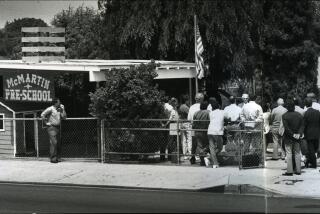A Speedy Trial Is the Rule, McMartin the Aberration : Courts: This case was exceptional in its complexity and numbers. It’s no sign of how most felonies are handled.
- Share via
The verdict in the McMartin Preschool child molestation case has focused renewed public attention on the criminal justice system.
Since the not-guilty verdicts were delivered last month, many in the public and the press have charged that McMartin illustrates all of the ills that plague the courts--including a costly legal process that is excruciatingly long and laborious.
But the impression that the McMartin case was representative of the speed at which the criminal justice system works is incorrect. McMartin was an aberration. It has been both the longest and costliest case ever tried. It initially involved a great number of defendants charged with many, many counts of very serious criminal behavior, over a six-year period. The testimony of children had to be relied upon to establish the crimes. Other events occurred in the course of the trial that made it more complicated and extended its length. (One defendant, Raymond Buckey, faces retrial on at least some of the 13 counts that the jury deadlocked on.)
While the public has criticized the Superior Court for being too slow in handling McMartin and other criminal cases, many people fail to understand the dimensions of the problem we face. The sheer volume of felony cases we process in Los Angeles County is mind-boggling. In the last 10 years, felony case filings have risen from 20,420 in 1980 to 32,308 in 1985 to 51,307 last year. That’s an increase of 151%. Civil, family law, juvenile, probate and other cases have increased as well, although not to the same extent. During this period, the number of Superior Court judges in Los Angeles County has increased by only 21%, from 196 in 1980 to 238 in 1989.
In spite of increased filings, the handling of felony cases has been speeded. During the first 11 months of 1989, the average time it took to determine the guilt or innocence of an in-custody defendant charged with a felony in the Central District, where the McMartin case was tried, was 48.4 days. The median adjudication time for these cases was 22 days. (The median is the midpoint along the range of case processing. Half of the cases take more than the median time to adjudicate; the other half, less.)
The National Center for State Courts recently studied felony case processing time at 26 trial courts around the country. While Los Angeles Superior Court was not included in the study, our median adjudication time would have tied for first place.
While our record for resolving felony cases is very good, we believe it can be even better. Over the past several years the Superior Court has worked cooperatively with other criminal-justice agencies to develop and implement numerous programs aimed at resolving cases before they get to trial, reducing the time it takes to try and sentence defendants and granting judges with complex cases additional time to concentrate on them, so they can dispose of them more quickly. Most people are unaware that Judge William Pounders, who tried the McMartin case, carried a full calendar of other felony matters until last summer, when we were able to open six additional courts in the Criminal Courts Building to speed felony case disposition and transfer the rest of his calendar to another judge.
Surely, lessons in how to expedite complex criminal cases can be learned from the McMartin case. But the public--and press--should not use this case as the yardstick by which it measures all others.
And when Ray Buckey is retried, his rights will be protected by the judge, just as mine or yours would be if we were charged with a crime. His guilt or innocence will be determined in a court of law by a jury of his peers. The jurors will be instructed that the defendant is presumed to be innocent until the contrary is proved, and that if they have a reasonable doubt as to whether his guilt has been satisfactorily shown, he is entitled to a verdict of not guilty. That’s the way our jury system should and does work--regardless of how much time it takes.
More to Read
Sign up for Essential California
The most important California stories and recommendations in your inbox every morning.
You may occasionally receive promotional content from the Los Angeles Times.










